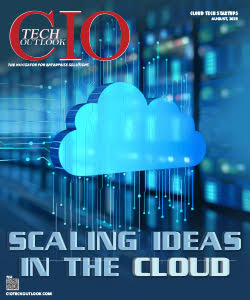Rising Importance of Hyperscale cloud services
Janifha Evangeline | Thursday, 17 March 2022, 15:00 IST

Hyperscale computing is a distributed infrastructure which can accommodate a surge in demand for internet-facing rapidly and back-end computing resources without needing cooling or electrical power or additional physical space. It is a data center that possesses huge amounts of storage, massive compute power, and extensive network fabric. In hyperscale computing, one can easily scale not just from a single server to a few but from a few hundred servers to thousands. Enterprises must have compute availability and automation to control the compute resources and Automation is key for hyperscale.
Hyperscalers
While hyperscale is a generic term, hyperscaler refers to one of a few very large, hyperscale level corporations that own huge data centers across the globe and these are often cloud providers that include Google for GCP, Amazon for AWS, and Microsoft or Azure. However, hyperscalers are not limited to just cloud providers, tech giants such as Facebook and Apple own huge data centers which are used to render services and for support internal operations. SaaS operators can also be hyperscalers. Between the big cloud providers and organizations such as Meta, they maintain more than fifteen million servers, and these are called Tier 1/mega hyperscalers.
In order to meet the accelerated pace of cloud adoption, hyperscale enterprises are looking to credible partners who can help realize their expansion requirements. Hyperscaler cloud service providers get global business solutions, outsourcing as well as consulting capabilities with an aim to support, enable enterprises to migrate, adapt & build cloud-native offerings. These cloud service providers leverage their cloud professional experience and talent to consult on application development, platform re-architecture, data migration & transitioning services from technology stacks into macro & microservices that are hosted in a private cloud, data center on-premise, public cloud/hyperscale etc.
Furthermore, with an infinite surge in amount data, connections, applications & workloads taxing on an enterprise’s ability to adapt as well as develop new platforms, testing, DevOps, security & governance requirements are hamstringing innovation, processes, and go-to-market efforts. This results in organizations working with partners to transition storage, computing, back-up as well as hosting services to cloud-based platforms to leverage the scale & compute power they can offer.
How can hyperscale providers help enterprises in their cloud-native programs adoption?
Buttressing a mass migration to the cloud
the covid-19 pandemic has made enterprises adopt public cloud services to a great extent and it is expected for cloud services to be a priority for enterprises disregarding their size in the coming decade. Businesses desire to offer end-to-end solutions by utilizing a mixture of on-premise, hybrid or public cloud platforms.
Hyperscale cloud service providers bring experience along with platform re-architecture by utilising the latest automated systems migration, Kubernetes, & containers. They leverage partnerships with hyperscalers for choosing the best fit for a purpose on workload specifications and they can provide industry-specific consulting on best practices for addressing internal as well as external governance, risk & compliance requirements.
Offering cloud migration value streams
Enterprises have moved from building in the cloud & subscribing to Software as a Service Solutions to migrating their monolithic application stacks to hybrid as well as public clouds. Therefore, this migration has disclosed the large amount of technology debt most of them have accumulated; hence, enterprises are prioritizing services providers who demonstrate the capabilities to hasten the discovery, assessment, migration, automation, management, as well as governance of applications & processes and effectively migrate them to either a hybrid or fully cloud-based platform.
Cloud-native strategies
Cloud-native strategies have resulted in a talent war for hyperscale services. And, New architecture, applications & tools for leading cloud providers mean that service providers can accelerate the skills of their customers.
The road ahead
“Public cloud growth continues to be driven by organizations that want to modernize their IT and reduce their capital expenditure spend. The desire for agility and innovation in both business transformation and IT operations is also fuelling the growth of public cloud,” said Sid Nag, research vice president at Gartner. “The next step in the growth of cloud in India will be the adoption of cloud native technologies. Indian CIOs will look to reimagine and refashion their applications and workloads using containers and microservices as well as artificial intelligence (AI) and machine learning (ML),” he adds.
Hyperscale is an exorbitant as well complex technology that an extensive majority of enterprises cannot afford or operate. It is impressive and offers huge processing power however it requires massive upfront expenditure. It is much cheaper and easier to process at hyperscale velocities by utilizing an existing hyperscale provider such as AWS, GCP or Azure. However, the latter option is also not cheap or easy as it will likely require us to rearchitect an application or the entire infrastructure to completely utilize hyperscale. While Lift and shift work in on-prem or the cloud, hyperscale requires cloud-native architectures.



.jpg)
